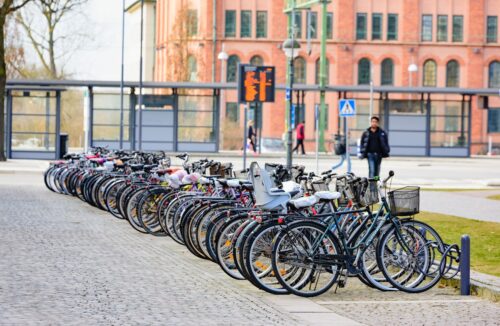Kristianstad, Sweden - March 20, 2016: A parking lot for bicycles close to the travel station in the background. People walking in background.

Converting Waste into Energy in Kristianstad, Sweden
What’s the best use for old cooking oil, potato peels, manure, and pig intestines? For residents of the city of Kristianstad, Sweden, the answer is energy. Kristianstad (pop. 81,000) is the lowest point in Sweden, several meters below sea level. Being well aware of the threats it faces due to climate change, in 1999 the city declared that it would become a fossil-fuel free municipality. It is almost there. Kristianstad, best known for being the home of Absolut Vodka, is heating its houses, fueling its cars, and powering its buildings with agricultural, food industry, and human waste.
From wood waste to energy
In the 1980s, with the spike in oil prices, Kristianstad started laying out pipes for a district heating system, hoping that would help it save on fuel consumption. The district heating system originally relied on fossil fuels. But in 1991 Sweden became the first country in the world to impose a carbon tax, and Kristianstad started looking for alternatives. The city, surrounded by forests, turned to biomass. In 1995 the city built Allöverket, a combined heat and power (CHP) plant producing 400 GWh of heat and 70 GWh of electricity from wood, bio-oil, and biogas. All of the wood used in the biomass plant comes from within a 100 km radius of the plant, from tree thinning, wood industry waste, and recycled wood. The 70 GWh of electricity produced each year is sold to the grid.
Currently, 11,800 buildings are connected to the district heating system, including 2,500 single-family homes, and the CHP plant is estimated to reduce annual CO2 emissions by 130,000 tonnes. Although there was a large upfront investment, about $144 million, for the CHP plant and increased district heating system, officials say the payback has already been significant. Kristianstad now spends less than half of the $7 million previously spent each year to heat its municipal buildings.
From pig guts to petrol
The region is also hotbed of agriculture and food processing, generating tons of waste each day from its farms and slaughterhouses. A biogas plant, Karpalund, was built in 1997 to turn all that waste into biogas to be used as fuel for cars. The biogas plant was built in a closed down sugar beet factory, and tanks from the former factory’s wastewater treatment plant are now used as digestion and storage tanks. Biogas from Karpalund substitutes approximately 4 million liters of gasoline and diesel per year, about 6 to 7 percent of the city’s total consumption.
The waste for the plant comes from a slaughterhouse, a distillery, licorice and potato farms, and residences. In 2005, organic kitchen waste was banned from Swedish landfills. All homes in Kristianstad now collect their kitchen scraps separately in paper bags that are collected every two weeks—by biogas-powered trucks—and brought to Karpalund. Manure from 22 farms is also added to the mix. Farmers deliver the manure and in return get free fertilizer, the output of the plant after the biogas is produced. Surplus fertilizer is sold to farmers not supplying manure for just under $3 per cubic meter. In 2013, the Karpalund plant produced 93,000 tons of liquid bio-fertilizer.
Seeing potential fuel everywhere, in 1999 the city entered into a joint venture with energy company E.ON to turn waste from the city’s sewage plant into biogas, also to be used as fuel for buses and cars. The city produces more biogas than can be used in its buses and cars, so the excess is “exported” to nearby municipalities. Currently biogas runs all 70 buses, 20 trucks, and 400 cars in the city, with three public gas stations offering biogas. Biogas is cheaper than gasoline due to the carbon tax on fossil fuels and the fact that it is produced from waste.
For a few years the city subsidized—through government grants—the cost of converting a car to biogas or purchasing a biogas vehicle, and provided owners of biogas cars with free parking.
Alternative Transportation
If you’re not keen on traveling by animal byproducts, the city has also installed over 163 km of bicycle paths. Other programs to promote cycling include an annual bicycle orienteering competition, bike-to-work and bike-to-school campaigns, and production of a pamphlet called Traffic Smart that compares different commuting alternatives between specific residential areas and workplaces, including time of travel, CO2 emissions, costs, and health benefits—shown by the amount of chocolate burned in calories by using the different methods (obviously bicycling wins).
Wind and Sun
The city is also investing in wind turbines and solar energy. There are currently 40 privately owned wind turbines producing 135 GWh of electricity per year. And two PV arrays produce 20 MWh of electricity per year, one located at the Naturum biosphere reserve and one powering houses in the Österäng multistory housing complex. In 2014 the municipality will install five more PV systems on municipal buildings totaling an additional 120 kW.
Through all of these measures, Kristianstad innovatively addressed several problems at once—disposing of waste, reducing pollution from transportation, and mitigating climate change. “It’s a much more secure energy supply—we didn’t want to buy oil anymore from the Middle East or Norway,” says Lennart Erfors, Kristianstad’s coordinator for local climate strategy. “And it has created jobs in the energy sector.”